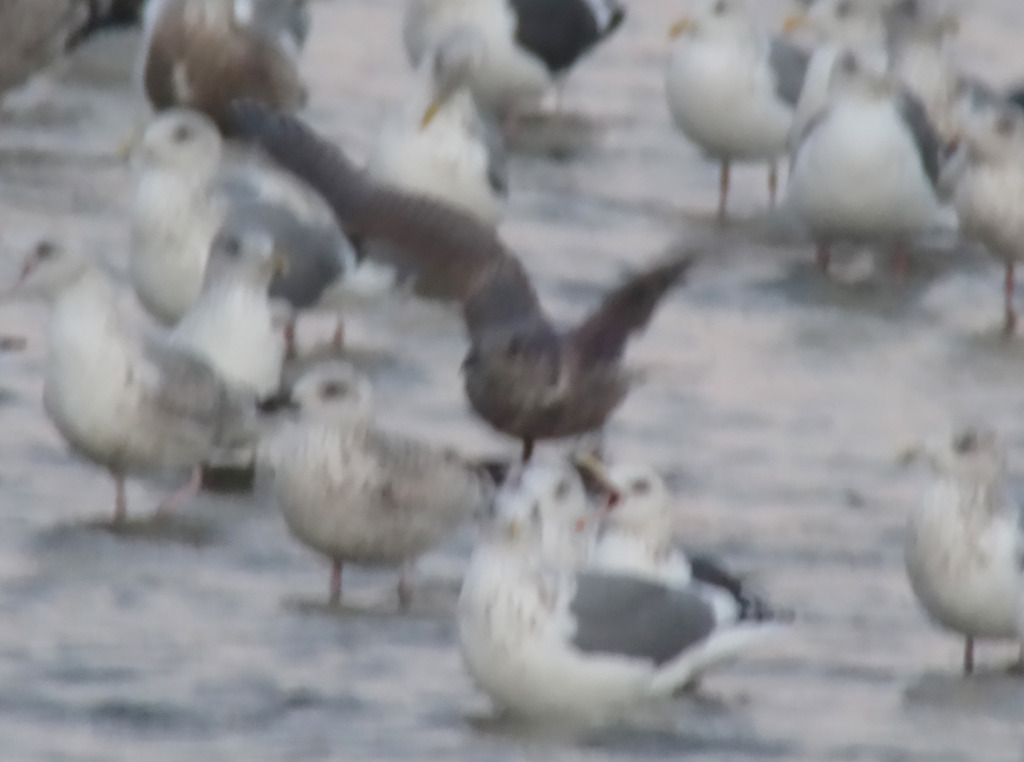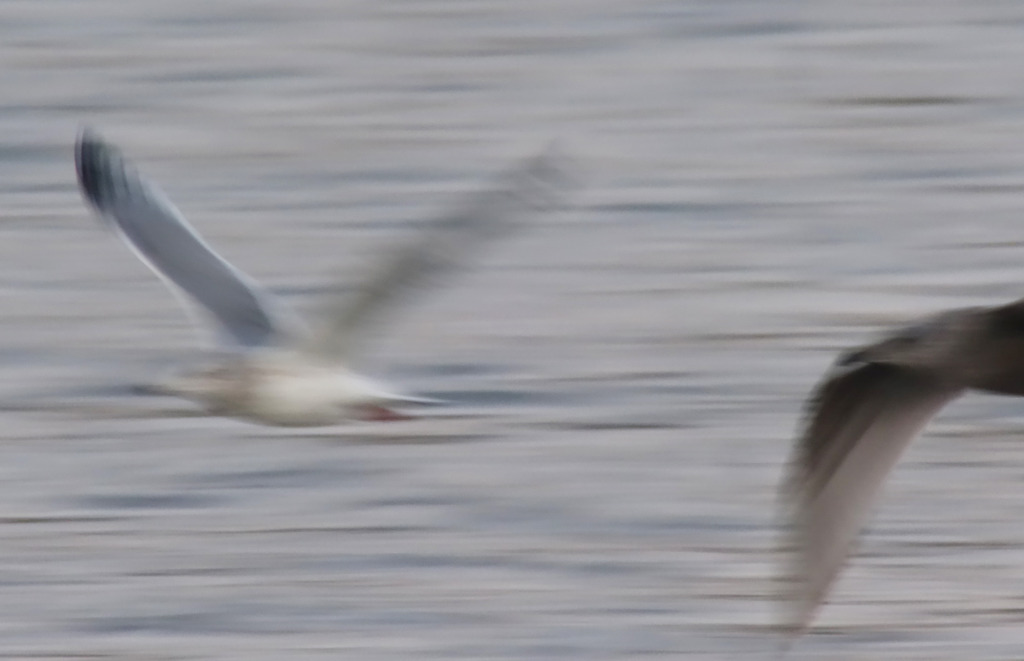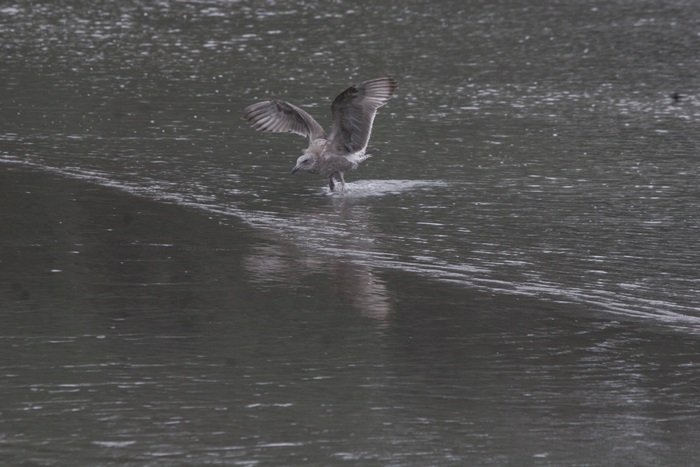The Gangneung Western Gull: Pure Enough or "just" a Hybrid American Gull?
- Dr. Nial Moores (migrated)
- Jul 7, 2015
- 9 min read
Nial Moores, July 7th/ 8th 2015 (with much essential input from Peter Pyle and Tristan McKee, in December and again in July 2015)
Revisiting a potential first for Korea (and Asia?) in the hope of more comments!
At dusk on December 6th 2014, I found a striking looking large gull in a river-mouth in Gangneung City on the northeast coast of the Republic by Korea (ROK). My immediate impression was that it looked closest to a First-winter Western Gull Larus occidentalis, a species previously unrecorded in Korea and perhaps even outside of North America. I therefore took a series of hurried digiscoped images through a superb Swarovski scope (20-30 in total, most in a two minute period as it preened, walked and then took flight, with the time-stamp helping to confirm that the standing and flying bird in the image sequences were the same); dictated some notes into my phone; and took some very short field notes, all the time mindful of the possibility / probability that this might instead be an exceptionally odd Slaty-backed Gull Larus schistisagus or a hybrid of some kind.

I quickly tried to call others in our team, and the bird was seen briefly by both Subhojit Chakladar and Jason Loghry as darkness started to fall.
That night, a quick review of images and my notes convinced me that it really did show many features of Western Gull (WEGU), a species I had seen a few times before in visits to California (many, but last in the 1990s) and BC (few, with many more hybrid-types, most recently in 2007). We revisited the river-mouth the next morning but could not find the bird again. We also shared the information with several other birders, in the hope that they could secure better images.

Still incredulous but hopeful it might be re-found, I mailed a few images and questions to Tristan McKee and Peter Pyle in California (as the three of us were then working together on a paper on Slaty-backed Gull identification). TM’s excited response was that it looked like a Western. He commented that the bill looked a little on the small side but within the expected range of a female; the underside of the primaries looked a little pale (raising the possibility of hybrid influence from Glaucous-winged Gull Larus glaucescens, a very frequent hybrid type); but finished by saying that “This bird would certainly be called a pure Western in California, with only that extremely blurred shot showing the undersides of the primaries [Figure 6 below] suggesting that they may be on the pale side (can’t really tell though)” (TM, in lit. December 9th 2014).
PP’s initial response was also encouraging, though rather more cautious, identifying several features that looked very good for Western Gull (including the wing coverts at rest) and other features which might suggest some hybrid influence. These included most especially the pale appearance of the undersides of the primaries in one (or more) of the images, and the apparent lack of obvious fringing on the upperparts.
Even a hybrid with some WEGU influence would be a great record this side of the Pacific (raising multiple questions!) , so I quickly wrote two online posts detailing the identification process (still both here), gradually adding extra images and commentary in order to help raise interest in this striking-looking bird. Together, we also tried to elicit the opinions of other gullers. There were only a few responses, however, and as the images were poor and some questions remained (including about the extent of photographic artefact), these responses were predictably a little mixed. Helpfully, though, the bird was considered by all who responded either to be a pure WEGU or a hybrid WEGU x Glaucous-winged Gull (GWGU). The main sticking point tended to be the appearance of the underwing. As shown in a series of images of underwings on the Slater Museum of Natural History website, the underwing is darkest in WEGU, paler in hybrids and palest in GWGU.
Interest in this “possible hybrid or Western-type Gull” within Korea seemed almost as cool as the weather, however. A few people did search for it, apparently, but sadly the bird was not refound.
During the next week or two, looking more closely at additional images which had not yet been posted because they were so blurry, I gradually became convinced that this bird actually had quite dark underwings. Like the upperwing, the underwing seemed to match pure WEGU better than hybrid WEGU x GWGU. A couple of these additional images are shown below.




Reviewing a draft of this note, and looking at these images, PP wrote “From these views of the underwing your bird easily matches that of the WEGU, especially concerning the dark tone to the underwing coverts.” (PP in lit. July 7th 2015).
If the underwing and upperwing can be considered to be within the range of WEGU, that still leaves the apparently odd lack of upperpart fringes as suggested by the images. This, combined with the poor light, makes the bird look very dark, even for a WEGU.
In mid-December, PP visited the California Academy of Sciences to research this feature. Through examination of WEGU collected from August through March, he was able to confirm that some First-cycle WEGU lacked obvious pale upperpart fringing. At that time PP wrote: “I’m more convinced that your bird is a ‘good’ WEGU… some of the birds had formative feathers that lacked fringing, though most had fringing. Earlier-replaced feathers seemed to have weaker fringing that can wear off, which may be the best explanation for this in the Korea bird. I was unable to find a December bird that had as many back feathers replaced, but all in all I’m satisfied now that the fringing issue is not a problem.” (PP in lit. December 18th 2014).
As the vast majority of (obviously) hybrid WEGU x GWGU show paler primaries in the closed wing at rest; and/ or pale underwings, and as this bird showed many “good” WEGU features, I gradually came to recognise that this bird was indeed a pure (or pure enough!) Western Gull. And while reviewing this draft, based on his much greater experience with and knowledge of this species and the appearance of hybrids, PP also concluded that “there is absolutely nothing else suggesting GWGU expression in the Korea bird” (Peter Pyle in lit. July 7th 2015).
It is perhaps helpful here to reflect a little on the meaning of “pure” and “good” and “minor hybrid influence”. At the widest level, there are multiple concepts for describing species and speciation; and closer to home, I am unaware of any checklist of Korean birds that has clear guidelines on how to assess or list hybrids or individuals that might (or might not have!) some minor hybrid influence. Such guidelines might be helpful to develop, not only to help assess national first records but also occasional records of species prone to hybridisation, like the Critically Endangered Baer’s Pochard. As PP wrote of this gull, “We’ll never know if there may be some small percentage of GWGU genes in it, and this may be the case even without any obvious phenotypic expression of GWGU. Given such blurry lines, for listing purposes, I’ve argued… that birds that are at least 7/8 one species should just be counted as such, and then we move on. It would still represent a bird from breeding populations of the vagrant species. Your WEGU obviously passes this test.” (Peter Pyle in lit. July 7th 2015)
Based on these additional images (which have been cropped, sharpened, brightened and had contrast reduced by 10-20% but otherwise unaltered), supported by the recounting of the identification process as above, do others with experience of Pacific gulls still see evidence of “some minor GWGU influence” in this bird, evidence of features that would suggest the gull e.g. was 1/4 or more GWGU? If so, please let us know.
Or do you agree instead that it is best identified and listed more simply as a Western Gull, the first record for Korea?
As we have no widely-accepted rarities committee, and as all identifications made for the Birds Korea Checklist are (always) open to expert independent input, your comments and opinions are genuinely warmly appreciated. Thank you in advance.







Comments